Throughout the history of the United States there have always been immigrants traveling to the country in search of a better life. And today, as the topic becomes increasingly entrenched in national discourse, it’s more important than ever to highlight the unbelievable value that immigration has brought to the U.S.—not just through key additions to our culture and diversity, but through the introduction of people who have helped make this country as great as it is. Similarly, for those seeking a peaceful and affordable retirement abroad, the Ecuador Retirement Visa offers an excellent opportunity to enjoy a new way of life. This visa not only provides retirees with a chance to explore Ecuador’s rich culture and natural beauty but also grants them access to a lower cost of living and quality healthcare.
Becoming a lawful permanent resident of the United States gives you certain privileges, such as protection under U.S. law. If you need an immigration attorney, look no further. A reliable service like DeJesus Law in Austin can take pride in providing affordable assistance to individuals and businesses alike who are navigating the complex world of immigration law. If you and your family are planning to migrate to the U.S., then you may consider getting help from family immigration lawyers. On the other hand, people who are in danger of being deported may seek the services of a deportation defense attorney.
If you’ve spent your entire life in the United States, it may be difficult to understand how different life is for citizens of many other countries, and how the rights we are afforded here are so integral to a free and fair existence. The American Dream isn’t just a philosophy—it’s a promise. Go Global Immigration Advisors has helped thousands of people get approved for their visa. And for the famous immigrants who made (and continue to make) their mark in this country, it’s a promise that was realized for both their benefit and for ours.
The list of famous immigrants to the United States is long, and may even include some people that you weren’t expecting. Read on to learn about some of the most notable U.S. immigrants and how their stories are reflected in the conversation around immigration today.
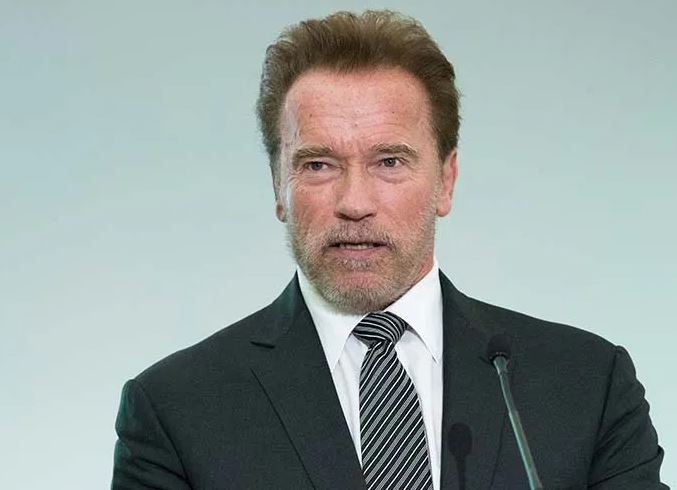
1. Arnold Schwarzenegger, Austria
Born: Thal, Styria, Austria
How do you go from a childhood in Austria to Governor of California? For Arnold Schwarzenegger, one of the most famous American immigrants, it was a long journey, and very rarely an easy one. Born into a poor, strict Catholic family with a former Nazi father who Schwarzenegger would later go on to describe as “abusive,” Schwarzenegger was often forced to forge his own path. He was an average student, but he found his footing early in life in the world of weight lifting, having picked up his first barbell at the age of 13. By 17, he was competing professionally.
In 1965, Schwarzenegger served one year in the Austrian Army—a requirement at the time for all Austrian males when they turned 18. He continued to compete in the bodybuilding circuit, and won the Junior Mr. Europe contest while still in active service. Soon after, he was voted the “best-built man of Europe,” which expanded his opportunities and got him a place in the Mr. Universe competition. Schwarzenegger later wrote on his website that Mr. Universe was “my ticket to America—the land of opportunity, where I could become a star and get rich.” And though he placed second, the competition put him in front of trainers, including one who took Schwarzenegger on, moving him to his home in London.
In London, Schwarzenegger started to fine tune his English speaking skills. Living with his coach gave him more stability than he was used to, and also provided him with the love and attention he had been lacking at his home in Austria. A year later, he took home first place in the Mr. Universe competition, becoming the youngest person to ever win the title. He won it again a year later.
After that, he decided to test his luck at something new, and moved to Los Angeles to become a movie star.
In 2002, LA Weekly described Schwarzenegger as one of the most famous U.S. immigrants, having overcome “a thick Austrian accent and transcended the unlikely background of bodybuilding to become the biggest movie star in the world in the 1990s.” Beating the odds once again, Schwarzenegger parlayed his movie star success—which included films like The Terminator and Junior—into politics, and in 2003 he won the Governorship of California with 55.4% of the vote. European newspaper The Telegraph referred to Schwarzenegger as living “the embodiment of the American dream,” a claim that few could deny. And though he has since retired from politics, he tweeted in 2018 that he believes U.S. immigration reform is necessary, but that “kids shouldn’t be pawns while the ‘adults’ figure it out.”

2. Mila Kunis, Ukraine
Born: Chernivtsi, Ukraine
Mila Kunis—full name Milena Markovna “Mila” Kunis—was born in Ukraine when it was still part of the Soviet Union. In the USSR, her mother was a physics teacher and pharmacy manager, and her father was a mechanical engineer and cab driver. And while they did okay financially, the family saw no future in the Soviet Union and were concerned with the ever lingering threat of anti-Semitism. In 1991, the Kunises moved to Los Angeles with seven kids, $250 in their pockets, and ambitions for a better life.
The transition to the United States was tough for young Mila, who, on her second day in Los Angeles, was enrolled in elementary school despite not being able to speak any English. Discussing the experience with the Los Angeles Times in 2008, Kunis said, “…I cried every day. I didn’t understand the culture. I didn’t understand the people. I didn’t understand the language.” Moving to the U.S. from the Soviet Union was like “being blind and deaf,” she added.
Like most child immigrants, Kunis did eventually adapt. And as her confidence with English grew, so too did her acting talents. Two years after moving to the states, she started acting classes, and she quickly booked her first gig: a Barbie commercial. By high school, Kunis had already taken on the role of Jackie Burkhart on That ‘70s Show, where she had an on-set tutor to help her keep up in school. From there she moved on to voiceover work on Family Guy, and then on to film, including movies like Forgetting Sarah Marshall, The Book of Eli, and Black Swan, the latter of which won her the Marcello Mastroianni Award for Best Young Actor or Actress at the Venice International Film Festival.
Kunis has always been open about her immigrant journey. In 2017, she contributed a piece to the memoir Six Words Fresh Off the Boat: Stories of Immigration, Identity, and Coming to America. So what six words did Kunis think best encapsulate the immigrant experience? “A better life for our children.”

3. Natalie Portman, Israel
Born: Jerusalem, Israel
Natalie Portman was born Neta-Lee Hershlag in Jerusalem. Both her maternal and paternal grandparents were immigrants themselves—her maternal grandparents’ families making their way from Austria and Russia to the United States and her paternal grandparents moving to Israel from Poland. Portman’s mother was raised in the U.S. and met her father, an Israeli, during college at Ohio State University. The couple married in Israel several years later and had one daughter (Natalie), who was born a dual citizen of the United States and Israel.
In 1984, when Portman was just three years old, the family returned to America for Portman’s father to attend medical school. They lived in Washington D.C., followed by Connecticut, and finally settled in Long Island, where Portman began studying ballet and modern dance. At 10, she was discovered by a modeling scout while out for pizza, and while she wasn’t interested in the career path, she did decide to start acting, eventually taking on Natalie Portman as her stage name. Her breakout role in Star Wars: Episode I – The Phantom Menace occurred while she was still in high school.
Portman may have been acting since a young age, but she has been equally ambitious in her studies. In 2003, she graduated from Harvard University with a degree in psychology, telling Fox News Network that she’d “rather be smart than be a movie star.” In 2004, she returned to Israel to attend graduate school at the Hebrew University of Jerusalem, but her movie career did not slow down—in 2010, she won the Academy Award for Best Actress for her performance in Black Swan, alongside fellow immigrant Mila Kunis.
Today, Portman maintains her dual U.S.-Israeli citizenship, though she has been critical of the political situations in both countries. Upon being
awarded the Genesis Prize in 2018—an award given to Jews who make a big impact in their field—Portman declined to attend the award ceremony due to dissatisfaction over the rule of Prime Minister Benjamin Netanyahu. She still feels strongly connected to Israel, however, once telling Rolling Stone that while she “really loves the states” her heart is in Jerusalem.
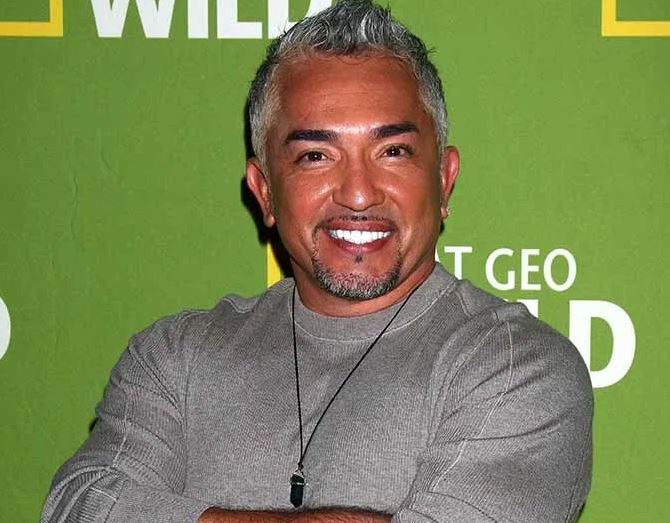
4. Cesar Millan, Mexico
Born: Culiacán, Sinaloa, Mexico
Long before he was the most well-known dog whisperer in America, Cesar Millan was known as el Perrero, or “the dog herder.” The name was given to him due to his natural talent for working with dogs, a talent he was able to show off quite a bit while working with animals on the farm in Culiacán , a city in Sinaloa, Mexico where his grandfather was a tenant farmer. It wasn’t until he was 13 and living in Mazatlan—another city in the Northwest Mexican state of Sinaloa—however that Millan realized he wanted to dedicate his life to working with dogs. And in December 1990, at the age of 21, Millan illegally crossed the Mexican border in Tijuana into the United States, carrying with him just $100 and a dream of a better life.
Like many famous immigrants before him, Millan spoke no English when he arrived in the states. His first few months in America were spent homeless in San Diego, California, before Millan was able to secure a job as a dog groomer and walker. It was through this job that he met actress Jada Pinkett Smith, who became a lifelong friend and who connected him with someone who could teach him English. He went on to become the world’s foremost dog trainer and behaviorist, eventually starring in The Dog Whisperer on the National Geographic Channel.
Millan’s immigration story echoes a lot of what we hear today about the risks of non-sanctioned immigration from Mexico. In addition to having very little money for his travels, Millan was forced to do the journey alone through dangerous border territory. He made his way into the U.S. via a hole in the border fence, which was guarded by a man who demanded Millan’s $100 for the passage. Since then, it hasn’t always been an easy road for Millan—both legal and personal controversies have followed his success. But today, Millan continues to excel in the dog training world, and in 2017 he released a memoir titled Cesar Millan’s Lesson’s from the Pack: Stories of the Dogs Who Changed My Life.

5. Sofia Vergara, Colombia
Born: Barranquilla, Colombia
While many of the most famous immigrants in America made their way to the country as children, Sofia Vergara didn’t make her move until she was 26—many years after she had already started a successful modeling and acting career in her home country of Colombia. It was a move driven by opportunity, but also by the dangerous climate of Colombia. Vergara’s older brother, Rafael, was murdered during a failed kidnapping attempt in 1998.
Before she was the famous brunette bombshell we know today, Vergara was a student at a Colombian university where she spent three years pursuing a career in dentistry. Everything changed however when she was discovered on the beach by a local photographer and started to receive offers to model and act on television. Her first big break was in a commercial for Pepsi, and she eventually began working on a Spanish-language travel show called Fuera de Serie (which translates to Out of the Ordinary), during which American audiences got one of their first major glimpses of her. In 1998, following the murder of her brother, Vergara and her family moved to Miami and Vergara started work on a Univision reality show titled A Que No Te Atreves (You Don’t Dare). It was about 15 years later that she landed her famous role on Modern Family.
Vergara spoke candidly about her immigration experience during a visit to Jimmy Kimmel Live!, saying that it took her a long time to finally get her citizenship, and even sharing that one of her brothers has since been deported. Becoming a U.S. citizen was “a very emotional moment for me,” Vergara told Kimmel, though she added that it was fun, too, and ultimately a positive experience.
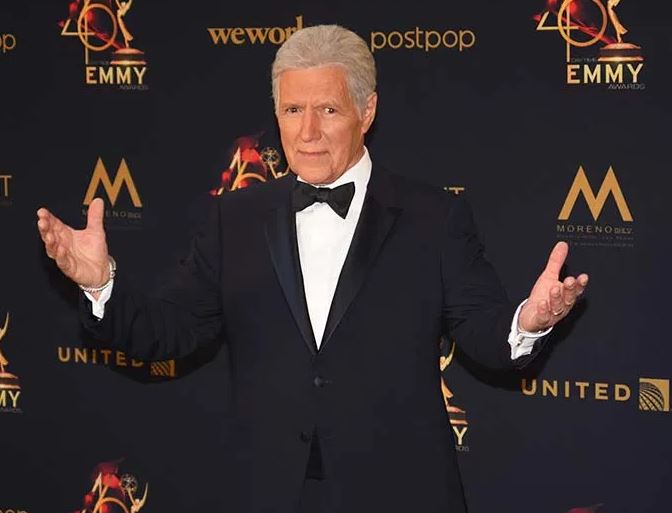
6. Alex Trebek, Canada
Born: Sudbury, Ontario, Canada
You may be surprised to learn that America’s favorite game show host actually hails from north of the border. Alex Trebek was born George Alexander Trebek in Sudbury, a town about a four hours’ drive north of Toronto. His father had immigrated to Canada from Ukraine as a child, and his mother was a native born Franco-Ontarian (also known as French Canadian). Trebek grew up speaking both English and French in his home, though it was in English speaking broadcast news that he began his long running media career.
Trebek’s first hosting gig was on the Canadian show Music Hop in 1963, when he was just 23 years old. This parlayed into additional hosting jobs, including game shows like Reach for the Top and Strategy. In 1973, Trebek took his career down south, immigrating to the United States to host a new NBC game show called The Wizard of Odds. Many hosting jobs followed, including Jeopardy!, the revival of which he began hosting in 1984. By 1991 Trebek was hosting three major network game shows (Jeopardy!, To Tell the Truth, and Classic Concentration) and in 1998 he finally became a naturalized U.S. citizen. He later joked that he received his first jury duty request just two weeks after obtaining his citizenship. Today, in addition to continuing to host Jeopardy! (at least until 2022, when his most current contract expires), Trebek owns and operated a thoroughbred racehorse breeding facility in California.

7. Bruce Willis, Germany
Born: Idar-Oberstein, Palatinate, Germany
Actor Bruce Willis was born Walter Bruce Willis to an American father and German mother in the mid-1950s. His father, David Willis, was an American soldier who moved his family—which included Bruce and his three siblings—from Germany to Carneys Point Township, New Jersey when he was discharged from the army in 1957.
Few may have thought that Willis would have gone on to become one of Hollywood’s leading men. At Penns Grove High School in Carneys Point, Willis was nicknamed “Buck Buck” by classmates due to issues that he had with stuttering. In an attempt to curb the stutter, Willis joined the high school drama club, a move that proved to work out for him both in terms of helping with his stutter and helping him develop his passion for acting. Eventually, Willis was appointed student council president and, a few years post high school graduation, went on to study drama at Montclair State University in Montclair, New Jersey.
Like many actors before him, Willis moved to New York immediately following college, where he worked as a bartender before taking over the lead role in an off-Broadway production of Fool For Love—often credited as his big break. Since then, Willis has had a long cinematic career, starring in such action and thriller classics as Die Hard, The Sixth Sense, Armageddon, and Unbreakable.
Willis’ status as an immigrant hasn’t played out much in his professional career, perhaps because he moved to the United States when he was just a toddler. However, the actor made a notable trip back to his hometown of Idar-Oberstein in 2005, where he surprised the inhabitants of his childhood home with a visit.

8. Sergey Brin, Russia
Born: Moscow, Russia
Google may be one of the biggest American companies ever founded, but it likely wouldn’t be anywhere without its Russian-American co-founder Sergey Brin. Brin was born in Moscow in the early 1970s, when Russia was still the Soviet Union. His parents were both intellectuals—his father a math professor and his mother a scientific researcher. The family sought to leave the Soviet Union in 1978 due to rampant anti-Semitism, though it was easier said than done. Upon applying for an exit visa, both of Brin’s parents lost their jobs and it was eight months of hardship before they could finally emigrate.
The Brin family moved to Vienna and then Paris, and then soon after to the United States when Brin’s father received a teaching position at the University of Maryland. Brin was still a child at this point, and while he quickly picked up English at his new school—the Paint Branch Montessori School in Adelphi, Maryland—his parents encouraged him to maintain his Russian language skills and helped him develop his math talents. Brin went on to gain a bachelor’s of science in computer science and mathematics from the University of Maryland, followed by a graduate fellowship in computer science at Stanford University. It was at Stanford where Brin met his fellow Google founder Larry Page.
Google first went online in 1998, but Brin has hardly slowed down in the time since. Today, in addition to being the 13th richest person in the world, Brin is engaged with efforts to combat the growing climate crisis, as well as medical innovation and research, among other endeavors.

9. Penelope Cruz, Spain
Born: Alcobendas, Spain
Penelope Cruz was born Penelope Cruz Sánchez in Alcobendas, a working class city in The Community of Madrid (also home to the metropolitan area of Madrid). Before turning to acting, Cruz excelled in dance. She studied classical ballet at Spain’s National Conservatory, which she has since credited with helping instill the discipline she applies to her acting today. The acting bug itself was caught early, and Cruz studied for four years at the theater school of Cristina Rota, a famous Spanish actress.
Cruz’s acting debut came at the age of 15, when she was in the music video for “La Fuerza del Destino,” a song by Spanish pop group Mecano. This soon parlayed into a television hosting gig, and eventually, roles in feature films, including Jamón, Jamón, a Spanish film also featuring actor Javier Bardem which gained her international acclaim and interviews with American newspapers and television shows. (Interesting fact: Cruz and Bardem starred together again in the 2007 film Vicky Cristina Barcelona, and in 2010, they got married.)
At the age of 20, Cruz moved to New York City to grow her acting career. There, she continued studying ballet, and also began to study English in order to have more success with U.S. casting agents. Her first American film was The Hi-Lo Country alongside Billy Crudup. And at 25, Cruz relocated once again, this time to Hollywood. In an interview several years ago with The Guardian, Cruz notes that she originally came to America with a return ticket to go back to Spain, but that she kept getting new roles and extending her stay. Some of her more popular titles include Blow, Vanilla Sky, and Pirates of the Caribbean: On Stranger Tides.
Cruz remains a hard working actress in the U.S. film industry, but she never actually gave up her Spanish citizenship, and still spends a lot of time there. As for where she feels most at home, Cruz told The Guardian that more so than feeling solely connected to one place, she feels like “a citizen of the world.”

10. Albert Einstein, Germany
Born: Ulm, Baden-Württemberg, Germany
It wasn’t the ivy leagues that brought Albert Einstein and his wife, Elsa Einstein, to Princeton, New Jersey in the fall of 1933. Rather, the world famous physicist, who had won the Nobel Prize in physics years earlier in 1921, came to the United States out of fear for his safety as the Nazis gained ground in Europe. He had reason to be afraid. Einstein, who was Jewish, had renounced his German citizenship when he was just 16 years old, in 1896, though he had returned to Germany in 1914 to teach at the University of Berlin. In the spring of 1933 the German government passed laws barring Jews from holding any sort of official position, including professorships at universities. Soon after, a German magazine put out a $5,000 bounty on him. And in 1933, Hitler officially came in to power.
Universities the world over sought to bring Einstein to their doors, but it was at the Institute for Advanced Study in New Jersey where Einstein chose to go. Several years later, Einstein wrote to then president Franklin D. Roosevelt about the looming threat of German Nazism and encouraged him to start work on an atomic bomb—a letter that is said to be largely responsible for the creation of the Manhattan Project, the U.S. research and development initiative that led to the creation of the world’s first nuclear weapons.
In 1940 Einstein officially gained his U.S. citizenship. And although he had been a staunch advocate of nuclear proliferation during the war, he remained a vocal opponent of nuclear weapons until the end of his days, and spoke widely about nuclear disarmament once the war had ended. He passed away in 1955 in Princeton.
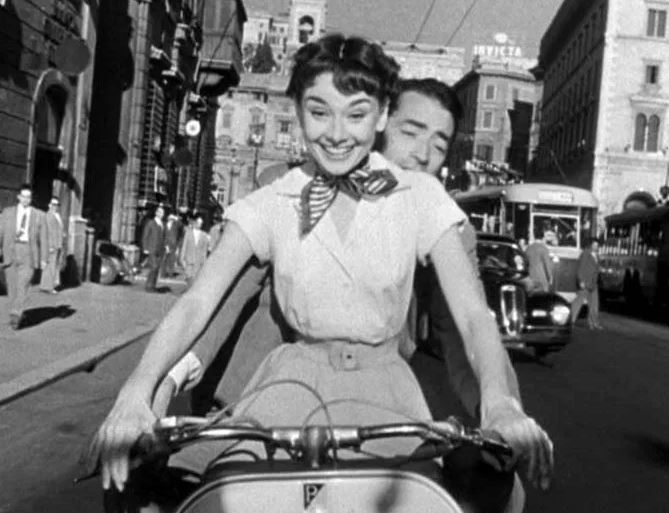
11. Audrey Hepburn, Belgium
Born: Ixelles, Brussels, Belgium
She may be on college dorm room posters across the U.S., but it’s actually Belgium that we have to thank for legendary actress Audrey Hepburn, born Audrey Kathleen Ruston in Ixelles, a suburb of Brussels. Her parents were immigrants themselves—her father a British citizen born in Austria-Hungary and mother a Dutch baroness. Her grandfather, Aarnoud van Heemstra, was the governor of Suriname, formerly Dutch Guiana, which is located in South America.
Hepburn’s childhood was spent traveling, in addition to the typical activities like school. The family—which included Hepburn’s two half brothers—often traveled between Brussels, London, and The Hague, and Hepburn picked up a number of languages along the way, including Dut
ch and English which she spoke at home, as well as Italian, French, and Spanish. When she was just six years old, Hepburn’s father left the family and moved to London, where he became involved with the British Union of Fascists. Hepburn’s mother, the Baroness Ella van Heemstra, moved with Hepburn first to her family’s estate in Arnhem, Netherlands, and soon after to Kent, England. They returned to Arnhem at the outbreak of the second World War.
After the war, the van Heemstras were left without their vast fortune. Hepburn’s mother began cooking and cleaning for a wealthy family, and Hepburn herself turned to acting. She made her film debut in Dutch in Seven Lessons in 1948 then moved to London to pursue ballet, though she soon left that endeavor to refocus on acting—and a move to the United States. In 1953, she had her first starring role as Princess Ann in Roman Holiday, for which she went on to win both a Golden Globe and an Academy Award for Best Actress.
Hepburn stopped acting in 1988—her last role was a cameo appearance in Steven Spielberg’s Angel—but her legacy extends far beyond her roles on screen. She was awarded the Presidential Medal of Freedom by former U.S. president George H.W. Bush for her work with UNICEF, and a Jean Hersholt Humanitarian Award from the Academy of Motion Picture Arts and Sciences for her humanitarian contributions. She passed away from cancer in 1992 at her home in Switzerland.

12. Liam Neeson, Northern Ireland
Born: Ballymena, County Antrim, Northern Ireland
Before he was one of Hollywood’s biggest action stars, Liam Neeson was a young man living in Northern Ireland playing sports (boxing and soccer), driving forklifts (for another famous Irish import: Guinness), and training to become a teacher. It’s not totally clear when Neeson first developed his love of acting, but at the age of 24 he began performing with the Lyric Players’ Theater in Belfast and soon after he moved to Dublin to further pursue his theater career. Soon, theater in Dublin turned into television and small budget films in London, and eventually a move to Hollywood in the late 1980s to take on bigger films.
Neeson’s career in the U.S. wasn’t always smooth sailing. The actor has previously noted that his thick Irish accent often served as a deterrent to getting roles, even as directors praised his acting skills. At the time, there weren’t many Irish actors in the states, at least those who were trying to go mainstream. It worked out, though—Neeson has starred (and many times, accent and all) in famous films such as Gangs of New York, Star War: Episode I – The Phantom Menace , and Kinsey. He’s also the star of the Taken series, and has lent his talents to such U.S. staples as Saturday Night Live and The Simpsons.
In 2009, a couple decades after his move, Neeson officially became a U.S. citizen. And on St. Patrick’s Day in 2017, Neeson joined other famous Americans with Irish roots in supporting the #IrishStand movement, an event speaking out against injustices to immigrants.
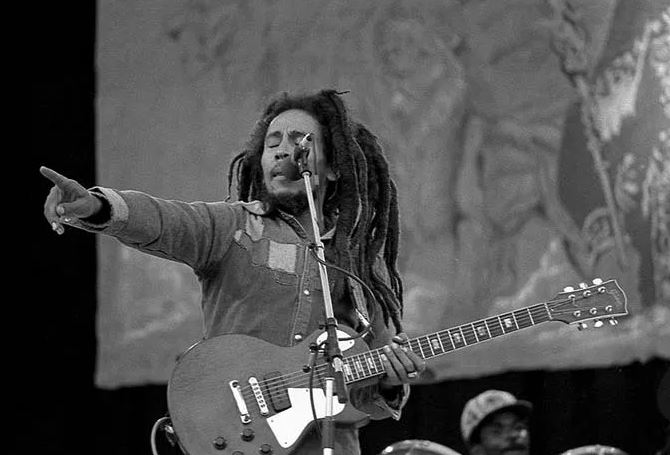
13. Bob Marley, Jamaica
Born: Nine Mile, Saint Ann Parish, Jamaica
Back when Jamaica was still under British rule, a young boy by the name of Robert Nesta Marley came into the world. His father was an English settler from Sussex, while his mother was Afro-Jamaican. Marley was 10 years old when his father passed away in 1955, after which his mother went on to marry a United States civil servant.
Music was always a big part of Marley’s life, in particular the R&B and ska hits coming out of the states. He found early inspiration in U.S. radio broadcasts, and started engaging with a network of fellow musicians after moving to Trench Town, a neighborhood of Kingston, the largest city in the country. Some of his musical peers during this time included Peter Tosh, Junior Braithwaite, and Joe Higgs, the latter of whom taught Marley how to play guitar. His first #1 hit in Jamaica came in 1964 when Marley was performing with his band, the Wailers.
Interestingly, it was a trip to America in 1966 that cemented Marley’s Jamaican roots. The singer, newly married, moved to Wilmington, Delaware for a short time to be near his mother, who had moved there previously. While working standard jobs—including a stint at the Chrysler plant in Newark—Marley became more engaged in Rastafarianism, a change that many attribute to his mother’s influence. When he moved back to Jamaica, he converted to Rastafari and grew out the dreadlocks that would become a staple of his appearance.
The Wailers biggest break came in 1972 when the band secured a recording contract with Island Records and embarked on a British and U.S. tour. Marley resettled in London, where he released some of his most well-known singles, such as “Exodus” and “Waiting in Vain.” Marley never moved back to the United States permanently, but it was while on tour in the country that Marley discovered that previously diagnosed cancer in his toe had spread throughout his body. In 1981, at the young age of only 36, Marley succumbed to cancer and passed away in Miami. Upon his death, his body was transported back to Nine Mile for burial, and later exhumed and reburied in Ethiopia upon request from his wife.
In his short career, Marley left behind a legacy that continues to traverse the globe—from Jamaica to America, and everywhere in between. He may not have been a U.S. citizen, but there is no denying that Marley is as large a part of the history of music in the country as local born musicians.
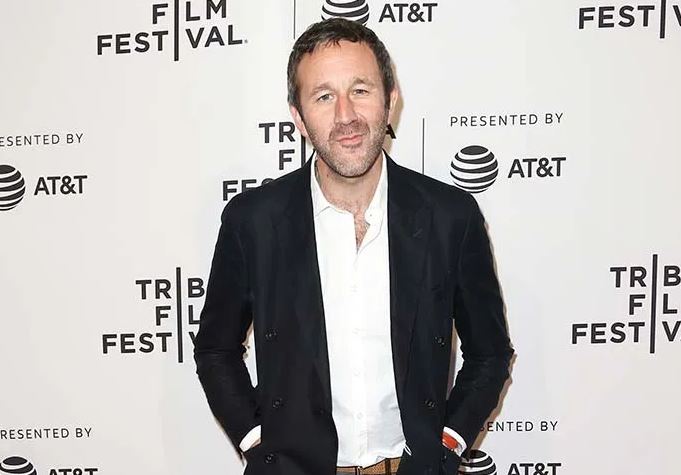
14. Chris O’Dowd, Ireland
Born: Boyle, County Roscommon, Ireland
Comedic actor Chris O’Dowd approaches the immigration experience similar to how he approaches his films: with intelligence, wit, and a hefty dose of undeniable Irish humor.
O’Dowd, who is well known for movies like Bridesmaids, Get Shorty, and Dinner for Schmucks, and who also has an established background in television and theater, put his feelings on full display at the 2019 Oscar Wilde Awards celebrating the U.S.-Ireland Alliance. Speaking out against current U.S. immigration issues, O’Dowd called out famous Republicans with Irish roots, including Sean Hannity, Mike Pence, and Kellyanne Conway, and implored them to remember “that your Irish immigrant ancestors are listening and you’re making their ears bleed.” It wasn’t the first time that O’Dowd had been vocal about today’s immigration climate, since, as he noted in the same speech as above, his own journey as a U.S. immigrant was “immeasurably smoothed” by the color of his skin and his financial means.
O’Dowd is not an American citizen—he and his wife, Scottish native Dawn O’Porter—have their green cards, but are not interested in pursuing full citizenship. His children, however, were born in the states and are dual citizens. His decision to maintain his Irish citizenship, even while living and working primarily in America, is probably driven at least in part by his family’s centuries’ long history in Ireland. O’Dowd told Marc Maron on the WTF podcast that his family has been in Boyle, County Roscommon since at least 800 A.D. But while he might not have his U.S. citizenship, O’Dowd has never been shy about recognizing his privilege as an Irishman in the states and continues to speak out regularly about the mistreatment of immigrants today.
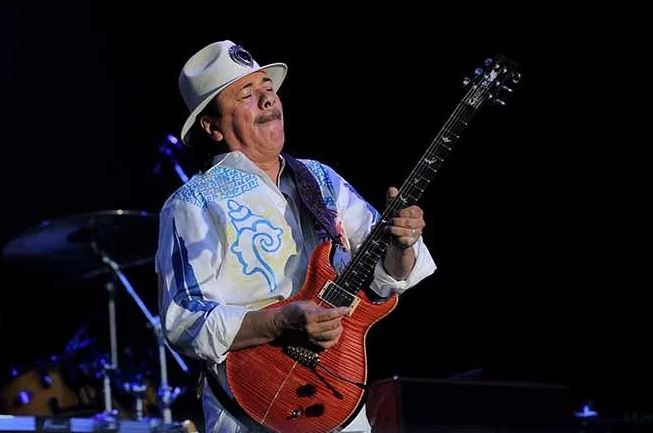
15. Carlos Santana, Mexico
Born: Autlán de Navarro, Jalisco, Mexico
Carlos Santana came to the U.S. via Mexico in the early 1960s, and became an American citizen in 1965, a year before he formed the Santana Blues Band, which went on to simply be called Santana. It wasn’t always smooth sailing though for the famous songwriter and guitarist, who told Rolling Stone in 2000 that shortly after arriving in the United States he took $20 his mother had given him and moved back down to Tijuana, the city his family had lived in most recently before making their way to the states. Santana was brought back a year later by his mother and brother, which is when he finally enrolled in school and decided to stay.
Although it didn’t take long for Santana to start his band, his early years in the United States were spent as a dishwasher in a San Francisco diner and a street performer. The Santana Blues Band was formed with two fellow street performers that he met during that time: bassist David Brown and keyboardist Gregg Rolie. In 1969, the band played at Woodstock, and the show was followed pretty soon after by a contract with Columbia Records.
Santana never lost touch with his Mexican roots, and in 2009 he was awarded a Lifetime Achievement Award at the Billboard Latin Music Awards. In 2014, he shared his immigration story—and the story of his amazing accomplishments—in a memoir titled The Universal Tone: Bringing My Story to Light.
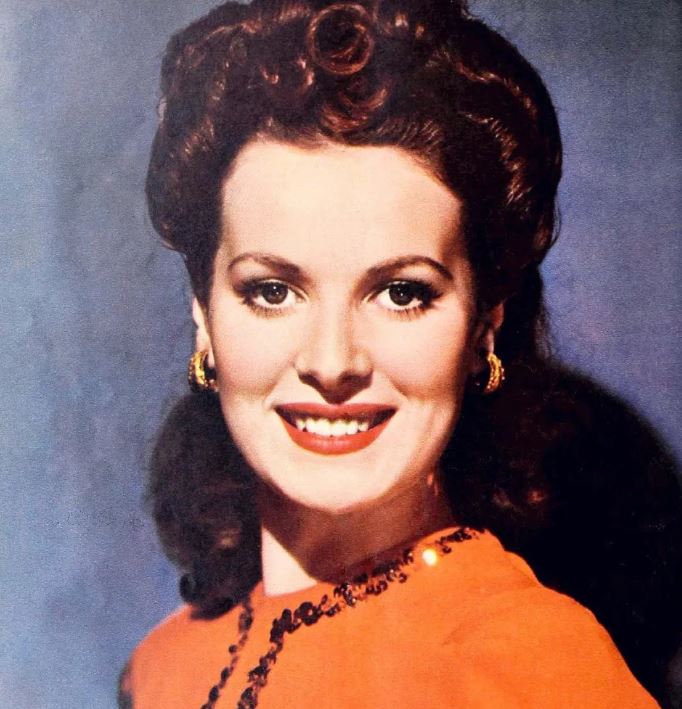
16. Maureen O’Hara, Ireland
Born: Ranelagh, County Dublin, Ireland
Maureen O’Hara isn’t just one of the most famous Irish actresses to ever immigrate to the United States—she’s also one of the most famous Irish immigrants ever. Born Maureen FitzSimons in Ranelagh, a suburb of Dublin, in 1920, O’Hara’s vivacious personality and affinity for the arts were recognized almost immediately. At the age of 5, reported O’Hara in her 2004 autobiography ‘Tis Herself, a gypsy predicted she would leave Ireland one day and become a world famous actress. This prediction in mind, O’Hara (at the time, still FitzSimons) made her movie debut in 1938, in a film titled Kicking the Moon Around.
It wasn’t long before O’Hara caught the eye of Hollywood director Charles Laughton and made her way to California, where she changed her name from FitzSimons to O’Hara and officially began her surge into U.S. stardom. In the decades to follow, O’Hara starred in countless films, including Alfred Hitchcock’s Jamaica Inn and alongside Lucille Ball in Dance, Girl, Dance. She is well known for starring as the love interest of John Wayne—a close personal friend—in a number of Westerns, including Rio Grande and Wings of Eagles, though it was her role in Miracle on 34th Street that she is perhaps best known for.
In 1946, O’Hara became the very first Irish immigrant to have “Irish” designated as her nationality on her U.S. citizenship papers after, as she put it in a speech for the 2001 Immigration Foundation Awards Gala, she made the judge “sick of her.” Previously, former Irish citizens were granted U.S. citizenship with “English” listed as their former nationality. O’Hara refused the designation, however, telling the judge that she would rather not have her U.S. citizenship than deny her Irish heritage. He eventually relented, in a move that would forever allow Irish immigrants to the U.S. to have their proper nationality written on their citizenship papers.
“I’m very, very proud of it,” O’Hara said in the speech, referring to her citizenship experience. “I could tell you stories about Irish immigrants and other immigrants too that [sic] I admire who have made wonderful contributions, not just to the United States of America, but to the entire world. … We are all citizens of the world and we can make it a more wonderful and better place.” O’Hara passed away in her sleep in 2015, though her film and immigration legacy are still strong today.

17. Gloria Estefan, Cuba
Born: Havana, Cuba
Gloria Estefan was born Gloria María Milagrosa Fajardo in Havana, the capital city of Cuba. Both of her parents were Cuban citizens, and her maternal grandparents had immigrated to the country from Logroño, Spain years earlier. The 1950s, when Estefan was born, were a tumultuous time in Cuba. The Cuban Revolution, led by Fidel Castro, began with an assault on the Moncada Barracks in 1953 and didn’t end until the overthrow of dictator Fulgencio Batista’s regime in January of 1959. In the years between, many Cuban families fled the country to safety, including Estefan’s.
The Fajardos arrived and settled in Miami, Florida in 1959. Estefan’s father, Jose, had been a Cuban soldier, but upon moving to the United States joined the U.S. Army and fought in the Vietnam War, including the infamous Bay of Pigs Invasion. Estefan’s mother, Gloria, had earned a PhD in Cuba but had to work hard to gain her U.S. teaching credentials, eventually ending up as a school teacher in the Dade County Public School System.
In 1975, while attending the University of Miami, Estefan—then still Gloria Fajardo—met Emilio Estefan Jr., also a Cuban immigrant, who was performing in a band called the Miami Latin Boys. After impressing him with her own singing prowess, she was invited to join the band, which then switched their name to Miami Sound Machine. Gloria and Emilio married in 1978, and Miami Sound Machine went on to release such hits as “Dr. Beat,” “I Need Your Love,” and the dance party hit “Conga.” The band dissolved in 1989 and Estefan became a highly successful solo artist.
Estefan’s family didn’t imagine that they’d be leaving Cuba forever when they immigrated during the revolution, Estefan told The Washington Post in a 2017 interview. In fact, she added, she still has her round trip Pan Am ticket tucked away in a safe. Her decision to stay in Miami is largely related to its close proximity to Cuba. “It’s as close as we can be to our roots and still live in this magnificent country with its freedom and its beauty,” Estefan told the newspaper.
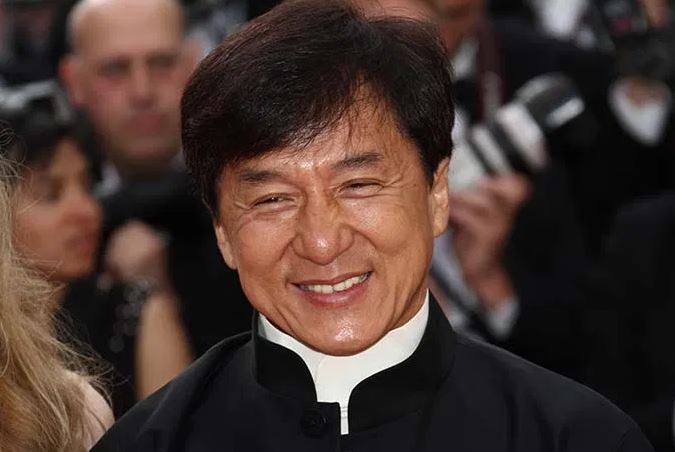
18. Jackie Chan, Hong Kong, China
Born: Victoria Peak, British Hong Kong, China
Few famous immigrants to America encapsulate the rags to riches trope quite like Jackie Chan. Born Chan Kong-sang in British controlled Hong Kong (now simply Hong Kong) to parents who were refugees of the Chinese Civil War, Chan was raised in poverty in the servants’ quarters of the French embassy where his father worked as a cook and his mother worked as a housekeeper. Chan’s family must have known that he was destined for great things, however, because he started appearing in small roles when he was just five years old.
It was Chan’s father who initially began putting the boy’s energetic qualities (his childhood nickname was “Pao-Pao,” which translates to “cannonball”) to use. The older Chan would wake up early with his son for one-on-one Kung Fu lessons, ending only when Chan eventually moved onto a professional Kung Fu Master named Yu Jim-Yuen. His knack for martial arts and performance led to Chan being enrolled in the China Drama Academy, which is where he first started working with Jim-Yuen. Chan excelled in his training and became a part of the school’s Seven Little Fortunes performance group, comprised of their best students.
While he was still in school, Chan’s parents immigrated to Canberra, Australia. Chan himself stayed in Hong Kong, where he was starting to grow in celebrity in the local film industry. Some of his earliest work there was as Bruce Lee’s stuntman in films like Fist of Fury and Enter the Dragon. When his Chinese film career started to stall, Chan moved to join his parents in Australia, attending college and adopting the name Jack, which over time became Jackie. His career didn’t fizzle for long though, and Chan eventually moved back to Hong Kong and broke away as a solo star outside of Lee’s shadow. Soon, he was the highest paid actor in the city.
Chan’s success in Hong Kong didn’t go unnoticed. He quickly gained fame across Asia, and was not only acting but producing and directing as well. His first Hollywood film—arranged by the Chinese production company Chan worked for—was The Big Brawl. It began a string of only very minor successes in the states, and eventually led Chan back to Hong Kong. Ten years later, he decided to take another stab at U.S. success and in 1995 starred in Rumble in the Bronx, which finally gained him the Hollywood recognition he was looking for.
Among famous immigrant in U.S. history, Chan is unique in that he managed to gain widespread career success here without ever becoming fully proficient in English. Rather than hold him back, his Chinese heritage has served to set him apart, with his success resting on his comedic timing and laurels as a martial arts master—and not simply his ability to adapt to what American audiences expect. To date, he has maintained his Chinese citizenship and continues to live in Hong Kong, though the actor also has a home in Beverly Hills.

19. Joseph Pulitzer, Austrian Empire, Hungary
Born: Makó, Kingdom of Hungary, Austrian Empire
Joseph Pulitzer, the man known for, among other things, persuading the United States to keep the Statue of Liberty in New York, was born in Makó, a town that was at the time in the Austrian Empire and now is part of Hungary. His ancestors had made their way there from Pullitz, Moravia (now the Czech Republic).
Pulitzer’s early life was a bit of a rollercoaster. The Pulitzers were a wealthy Jewish family in Makó and the young Pulitzer enjoyed private tutors and plenty of luxury in his youth. After his father’s death when Pulitzer was 11, however, the family lost their fortune and became impoverished. With his eyes set on prosperity, Pulitzer traveled to Boston at the age of 17. His passage was paid for by Massachusetts military recruiters who thought he would make a good addition to the Union Army (it was 1864, a year before the end of the Civil War). And join the army he did, enrolling in the Lincoln Cavalry in New York soon after crossing the sea.
After the war, Pulitzer worked odd jobs and tried to cobble together a living. He also renounced his Austro-Hungarian citizenship, becoming a naturalized U.S. citizen in 1867. Pulitzer’s impressive work ethic caught the attention of two attorneys who helped him get a job with the Atlantic and Pacific Railroad. From there, Pulitzer moved on to newspapers (Pulitzer eventually owned The Saint Louis Post-Dispatch and New York World—at one point the most widely circulated paper in the country) and politics (he was a staunch Democrat, and at one point, an elected congressman from New York).
Pulitzer left a lasting mark not just in media and politics but in academic discourse. Soon before his death, Pulitzer funded the opening of the Columbia School of Journalism in New York, the first journalism school in the country. It was a move that inspired the creation of the Pulitzer Prize after his death. He was also instrumental in the founding of another top journalism school, this one at the University of Missouri.
As for his history with the Statue of Liberty, it was Pulitzer who funded the pedestal for the statue—a gift to America from France—when the American Committee for the Statue of Liberty ran out of funds.
Learning From Immigrant Experiences
Reading about famous immigrants in American history is certainly entertaining, but it also serves a greater purpose. It is important to always remember that those who have the most to contribute to this country aren’t always necessarily born within its borders. The list of famous immigrants above is just a small sampling of the amazing things that immigrants have achieved in America.
We hope that you enjoyed learning about famous U.S. immigrants. Browse our site to find helpful tips for planning your next move.

20. Sammy Sosa, Dominican Republic
Born: Consuelo, Dominican Republic
Seven-time All Star baseball player Sammy Sosa was born Samuel Kelvin Peralta Sosa in Consuelo, a small town outside the larger Dominican city of San Pedro de Macorís. He grew up in poverty, with his father—a farmer—dying when Sosa was just seven years old. Sosa, his mother, and his six siblings lived in a two-bedroom apartment within an abandoned hospital—a far cry from where Sosa would eventually end up. Sosa’s early years were spent selling oranges and doing janitor work at a shoe factory to help support his mother and siblings, but it was during his off time that he started to develop the skills that would propel him to American greatness. It was his brother, Juan, who encouraged Sosa to start playing baseball at the age of 14. Two years later, the innately talented Sosa signed a contract to play for the Texas Rangers.
Sosa’s first visit to the United States was for Texas Rangers training camp in Sarasota, Florida. It took three years for Sosa to make his major league debut for the Rangers, but once he did, he quickly caught the eye of the Chicago White Sox, who negotiated a trade for the gifted Dominican baseball player. It was a good trade, too: in his first season with the White Sox, Sosa hit an amazing 15 home runs. Several years later, Sosa was traded to the Cubs, and in 1998 he gained coast to coast fame as he battled it out with Mark McGwire of the St. Louis Cardinals for the league home run record (McGwire edged Sosa out, scoring 70 home runs to Sosa’s 66).
Unsurprisingly, his success in the United States and the way of life that came with it were highly appealing to Sosa, and he made his citizenship official in 1995. And while his career hit some rocky roads—including cheating and drug use allegations—Sosa has continued to prosper in the states. He lives in Florida with his family, including his wife, Sonia Rodriguez, who is also from the Dominican Republic.
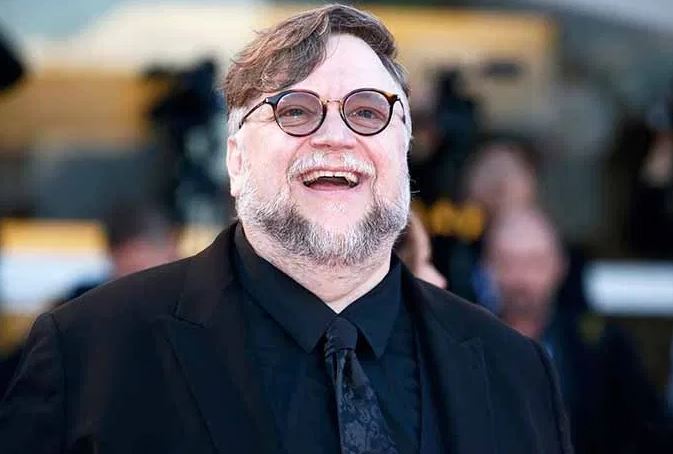
21. Guillermo del Toro, Mexico
Born: Guadalajara, Jalisco, Mexico
Arguably one of the most famous filmmakers in America in addition to one of the most famous Hispanic immigrants, Guillermo Del Toro’s love for cinematic creation started long before he ever stepped foot in the United States. His first Hollywood film, Mimic, starring Mira Sorvino, was released in 1997. Prior to that, del Toro studied at the University of Guadalajara’s Centro de Investigación y Estudios Cinematográficos, and even started his own special-effects company, Necropia. His debut feature film, Cronos, released in 1993, won nine Ariel Awards from the Mexican Academy of Film—an award similar to an Oscar.
In 2017, del Toro won an Oscar for Best Director for his film The Shape of Water (a film that also won Best Picture), and used the opportunity to herald his experience as an immigrant and how it shaped him into the director he is today. “I think the greatest thing our art does and our industry does is to erase the lines in the sand,” del Toro said in his acceptance speech. “We should continue doing that when the world tells us to make them deeper.”
Del Toro has managed to maintain strong Mexican roots even as he has become a mainstream American filmmaker. Many of his most popular films, including Pan’s Labyrinth and The Orphanage, are in Spanish with English subtitles. Most recently, del Toro made headlines during his Hollywood Walk of Fame Ceremony when he posed with a Mexican flag and told listeners “not to believe the lies” told about immigrants. “Believe in the stories you have inside, and believe that we all can make a difference, and we all have stories to tell, and we all can contribute to the art, and the craft, and the world in any way we see fit,” he said.
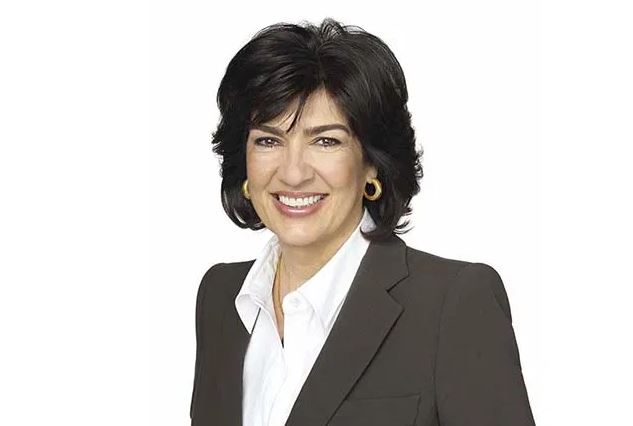
22. Christiane Amanpour, England
Born: London, England
Like many foreign-born journalists before her, Christiana Amanpour’s status as a U.S. immigrant has given her a unique perspective that it is integral to her work. Amanpour was born in London, the daughter of a Persian immigrant father (he immigrated to the United Kingdom from Tehran, the capital of Iran) and a British mother. She spent much of her early years exploring her Persian heritage while at elementary school in Iran, though the family returned to England after the Iranian Revolution began.
After high school, Amanpour decided to move to the United States to study journalism, which she began doing at the University of Rhode Island. She graduated summa cum laude in 1983 with a number of journalism jobs under her belt. After college, Amanpour was hired by CNN in Atlanta to serve as an entry-level desk assistant. Her first major assignment was to cover the Iran-Iraq War, which had continued during her schooling. This resulted in a move to Eastern Europe for on-the-ground reporting on the fall of communism in Europe, and eventually, a storied international correspondent career for CNN that had Amanpour traveling and reporting all over the world.
Amanpour married former U.S. Assistant Secretary of State and U.S. State Department Spokesman James Rubin in 1998 and settled in New York City. In 2003, she relocated to London permanently (and later announced a divorce from Rubin). And while she still lives in London, Amanpour continues to be an authoritative voice for international news in the states, especially after replacing Charlie Rose on PBS in 2018 with a show titled Amanpour & Company.

23. Charlize Theron, South Africa
Born: Benoni, South Africa
Charlize Theron was born in Benoni, which is in the Gauteng Province (formerly the Transvaal Province) of South Africa. Her ancestors had made her way to South Africa from France, though she has Dutch and German ancestry as well.
It’s hard to imagine that this statuesque A-lister was ever anything but a movie star, yet Theron’s early years were actually spent as an only child tending livestock on her parent’s Benoni farm. Her first language is Afrikaans, a daughter language of Dutch that is spoken throughout South Africa. It’s unclear when she first started learning English, but it may have been in her early teens, when Theron, a talented dancer, began attending boarding school at the National School of the Arts in Johannesburg.
Theron’s life changed dramatically at the age of 16, when she won a one year modeling contract and moved with her mother, Greta, to Milan, Italy. When the contract ended, Theron relocated once again, this time to the United States, while her mother returned to South Africa. In the states, Theron began attending the Joffrey School of Ballet in New York. She left only upon suffering an injury that cut her dancing career short, an experience that Theron once told the New York Times led to a major depressive episode. Hoping to cheer her daughter up, Greta purchased Theron a one-way ticket to Los Angeles so she could try her luck in the film industry.
Theron’s film debut was a non-speaking part in Children of the Corn III: Urban Harvest, but it wasn’t long before she was booking more robust roles in films like The Devil’s Advocate and The Cider House Rules. These led to The Italian Job, for which Theron was widely acclaimed, and then Monster, a film that won her Best Actress at the 76th Academy Awards.
In 2007, Theron officially gained her U.S. citizenship. Speaking to the Irish Examiner a year later, she mentioned that part of her inspiration for gaining citizenship was the travel allowances afforded by a U.S. passport, adding that she does feel like she’s “really at home here.” And in 2018, Theron talked to Total Film Magazine about her immigrant experience, and how the difficulties of being on her own in a new country fueled her to work harder. “I could be on a flight back to South Africa. I didn’t have a family in the US; I didn’t have a support system here. That drove me. I was responsible for myself, and I could not take anything for granted,” Theron told the magazine.
Theron continues to live in Los Angeles, and has become internationally recognized not just for her acting but for her philanthropy. She was honored in 2008 by the United Nations as a messenger of peace, and is a vocal advocate for The Global Fund, which helps fight infectious diseases throughout the world.

24. Ayn Rand, Russia
Born: St. Petersburg, Russia
Author Ayn Rand was born Alisa Zinovyevna Rosenbaum in St. Petersburg in 1905, in what was formerly known as the Russian Empire but is now just Russia. Rand’s childhood was spent in the last years of Imperial rule, during which she enjoyed a fairly easy life, attending a prestigious school and engaging in the sorts of intellectual debates one would expect of such a prolific writer and thinker. In 1917, however, the Russian Empire came crashing down, with the Bolshevik’s ousting Tsar Nicholas II and many families—including the Rosenbaums—fleeing the strife of the major cities. During that time, Rand’s family moved to the Crimean Peninsula, though they later moved back to St. Petersburg.
Rand was among the first women allowed to attend university in Russia—a benefit that came around after the Russian Revolution. Her studies there were briefly cut short by a purge that removed the bourgeoise from schools, but she was eventually allowed to return, and she graduated in 1924.
During all of her school years, Rand always had a passion for big ideas about philosophy and society—ideas that she originally wanted to convey through screenplays. In late 1925, she was sent to visit relatives in Chicago and fell in love with the United States. Refusing to return to Russia, Rand spent several months with her U.S. family and then headed to Hollywood to pursue her screenwriting dreams. There, she met famed director Cecile B. DeMille, who gave her a role as an extra on his film The King of Kings and then a position as a junior screenwriter.
While working on The King of Kings, Rand met actor Frank O’Connor and the two married in 1929. Two years later, Rand received her American citizenship, and from the outset was engaged with American politics and the philosophies behind it. Ayn Rand and Frank O’Connor worked as full-time volunteers on the failed 1944 presidential campaign of Wendell Wilkie, which led to Rand meeting many other intellectuals interested in the same ideas that she was. She began a public speaking career, where she questioned American history and politics while suggesting her own ideas for how society could be better arranged. These ideas form the basis of many of her most famous works, including The Fountainhead and Atlas Shrugged.
Perhaps even more interesting than Rand’s ideas themselves is how, as an immigrant, she has been able to permeate Americans’ own ideas about the culture they inhabit. In 1991, Library of Congress book club members voted Atlas Shrugged the second most influential book in their lives, second only to the Bible.
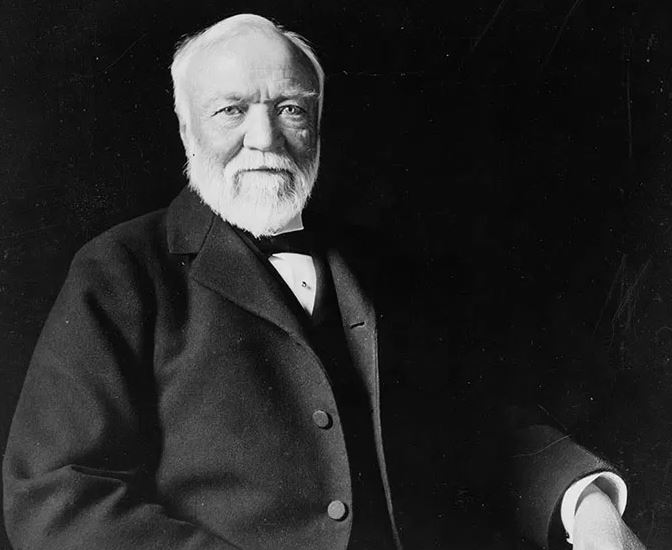
25. Andrew Carnegie, Scotland
Born: Dunfermline, Fife, Scotland
Andrew Carnegie, synonymous with American prosperity and philanthropy, was born in Scotland in 1835. And long before he beat out John D. Rockefeller for the title of wealthiest American, Carnegie was a boy in Scotland in a one room, working class home. At the age of 13, Carnegie and his parents left the financial hardship of Scotland and moved to the United States, settling in Allegheny, Pennsylvania, where Carnegie got his first job in America: a 12 hour a day, six day a week factory gig that paid $1.20 a week.
Allegheny was a rapidly expanding town when the Carnegies moved there, well known for its industrial advancements. And soon, the young Carnegie caught some luck, starting with a job offer from a fellow Scottish immigrant who also ran a factory. Carnegie established himself as a hard worker, a skill he eventually brought with him to future jobs, including roles as a telegraph messenger boy and, after working his way up, the superintendent of the Western Division of the Pennsylvania Railroad Company. Carnegie started investing his earnings and then investing in U.S. industrial advancements, in particular the steel and railroad industries.
It was during the Civil War that Carnegie began to truly establish himself as a mainstay of the American elite. In 1861, Carnegie was appointed Superintendent of the Military Railways and the Union Government’s eastern telegraph lines. After the war, he turned his focus back to steel, amassing the fortune that he would eventually become world famous for.
Carnegie wasn’t just one of the richest of famous U.S. immigrants, he was also one of the most philanthropic. In the last 18 years of his life, Carnegie gave away roughly 90% of his fortune to charitable causes, including those in both the United States and in his hometown of Dunfermline. He funded the opening of around 3,000 libraries around the globe in his lifetime, starting in Dunfermline and working his way through the U.S., Britain, Australia, and beyond. He further invested in education with Carnegie Mellon University and millions in educational grants. During this time, Carnegie split his time between Skibo Castle, his home in Scotland, and his U.S. estates.
Carnegie passed away at his home in Lenox, Massachusetts, having given away the equivalent of nearly $77 billion in today’s money. The remainder of his fortune was given to charity after his death.
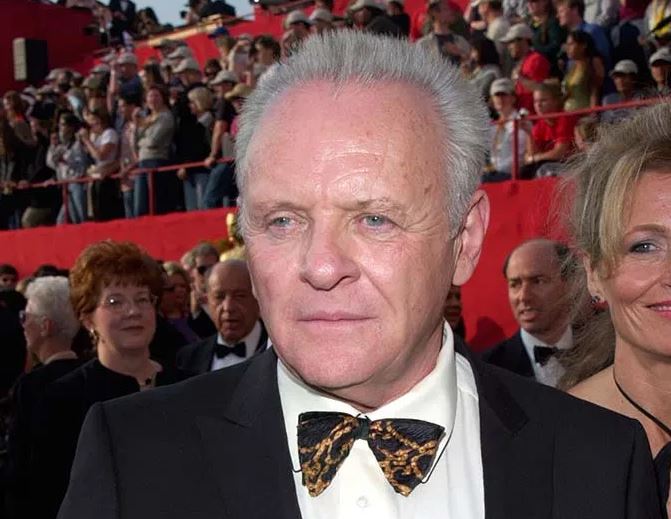
26. Anthony Hopkins, Wales
Born: Margam, Port Talbot, Glamorgan, Wales
Sir Philip Anthony Hopkins was born on New Year’s Eve in Margam, a suburb in Wales near the coastal town of Port Talbot. Hopkins was raised in a working class family with strict values, however he discovered at an early age that the work he himself was most passionate about had nothing to do with school or a traditional career. A young Hopkins immersed himself in drawing, painting, and piano playing, which wasn’t great for his grades or his confidence—he later told The New York Times that he was led to believe he was “stupid” due to his poor school performance.
Inspired by fellow Welsh actor Richard Burton, Hopkins left traditional schooling at 15 and enrolled at the Royal Welsh College of Music & Drama. There, Hopkins finally found his footing, and in 1960, after completing two years in the British Army, he moved to London to attend the Royal Academy of Dramatic Art. His first stage performance was that year in a production of Have a Cigarette, which eventually parlayed into a celebrated television and film acting career. This includes The Silence of the Lambs, a movie that Hopkins won the Best Actor Academy Award for in 1992, despite appearing in only 17 minutes of the two hour plus film. The role came at a time when Hopkins was debating abandoning the small and silver screen to return to theater, though it was sufficient to change his mind.
As one of Hollywood’s most prolific leading men, it’s no wonder why Hopkins decided to make America his home. Although he was knighted by the British Empire in 1993 for his exceptional talents in film, he chose to make it official with the United States in 2000, becoming a naturalized citizen. Speaking later to a British entertainment news publications, Hopkins noted that he still feels very much connected to the United Kingdom. “I have dual citizenship; it just so happens I live in America,” he said. Today Hopkins continues to steal the scene, even in his 80s. His most recent breakout role is the secretive and sinister Robert Ford on HBO’s Westworld.
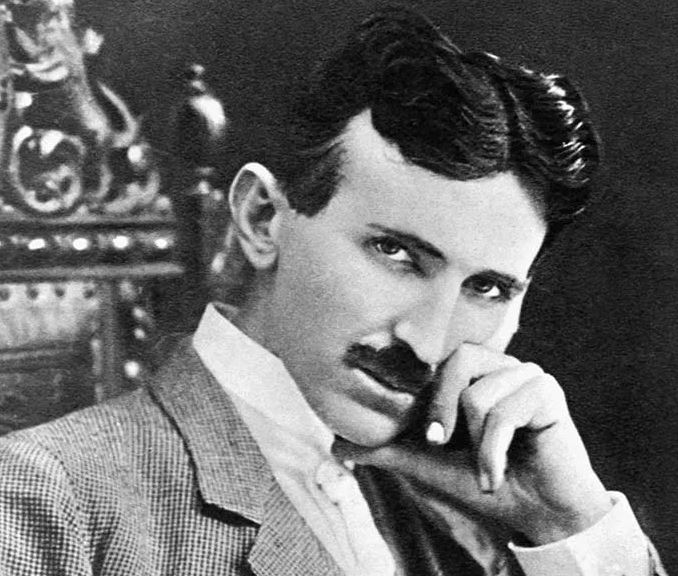
27. Nikola Tesla, Austrian Empire, Croatia
Born: Smiljan, Austrian Empire, Croatia
You don’t become the eponymous inspiration for Tesla without leaving an impressive trail behind you, and that can certainly be said for Nikola Tesla, who was born in 1856 in Smiljan, a small Croatian village back when the area was still part of the Austrian Empire. Tesla came from a line of Serbian Orthodox priests, his father and his maternal grandfather both having held the title. His earliest primary school years were spent in Smiljan, but the family soon moved to a nearby town called Gospić. Tesla attended high school at the Higher Real Gymnasium in Karlovac, where he first became interested in physics and demonstrations of electricity.
Tesla’s schooling went on for many years, and at one point, a professor was so concerned about how hard he worked himself (Tesla claimed he worked on his studies 20 hours a day, seven days a week) that he wrote Tesla’s father to warn him. When he eventually dropped out of school, Tesla hid the fact from his family for fear of their disappointment, though they found out either way. Around this time, Tesla experienced a nervous breakdown, and his father died of an unspecified illness.
Working his way back into his career, Tesla began teaching at his old school in Gospić, and in 1881 moved to Budapest, Hungary to work for the Budapest Telephone Exchange. This move precipitated a relocation to Paris to work for the Continental Edison Company. And in 1884 when his manager at Edison was transferred to the United States, he requested that Tesla go with him. Tesla immigrated to New York City that very same year. He left Edison soon after and opened his own company, Tesla Electric Light & Manufacturing where he focused on advancements like alternating-current dynamos and radio technology, the latter of which he might be most known for (the Tesla coil, in particular).
Tesla moved around the U.S., from New York City to Colorado Springs to Long Island, and made friends with the likes of Mark Twain and Francis Marion Crawford. He became a naturalized U.S. citizen in 1891, the very same year that he patented the Tesla coil. He died in 1937, leaving behind a legacy as one of the most famous immigrants in American history and most celebrated inventors of all time.

28. Henry Kissinger, Germany
Born: Fürth, Bavaria, Germany
Henry Kissinger, the 56th United States Sec
retary of State under presidents Richard Nixon and Gerald Ford, was born Heinz Alfred Kissinger in 1923 in Fürth, a small city in south-central Germany. Kissinger’s family was Jewish, and in 1938 they left Germany for London in response to rising Nazism and threats against Jews. Soon after, the Kissingers immigrated to New York, where they settled in to Washington Heights, an Upper Manhattan neighborhood with a large population of fellow German Jewish immigrants.
Kissinger’s journey from German teenager to U.S. politician likely has its roots in 1943, when he was drafted into the U.S. Army. Kissinger was stationed in South Carolina when he became a naturalized U.S. citizen. During World War II, Kissinger made his way back to Germany, this time to the city of Krefeld as a private. His ability to speak German was a major asset to his division, and helped him accomplish the army’s goal of establishing a civilian administration in Krefeld within a very short period of time. In 1945, Kissinger helped with the de-Nazification efforts in nearby Hesse.
After his time in the army, Kissinger returned to the United States and graduated summa cum laude with a degree in political science from Harvard College. He received his master’s and PhD from Harvard, and eventually became a faculty member in the Department of Government. Kissinger quickly established himself as an expert in U.S. foreign policy, co-founding the Center for International Affairs and releasing a book titled Nuclear Weapons and Foreign Policy. He was a foreign policy advisor to Nelson Rockefeller during his bids for the Republican presidential nomination in 1960, 1964, and 1968, and, when Richard Nixon became president in 1968, was appointed National Security Advisor, a role that eventually led to him becoming the U.S. Secretary of State.
Despite being born in Germany, Kissinger is one of the foremost American political icons. He was instrumental in shaping U.S. policy during the Vietnam War, and even after he retired from politics in 1976 he remained an advisor to Republican leaders and conservative think tanks. In 2008, he founded the Kissinger Institute on China and the United States, a non-profit organization dedicated to preserving relations between the two superpowers and attempting peaceful cooperation, particularly in terms of immigration.
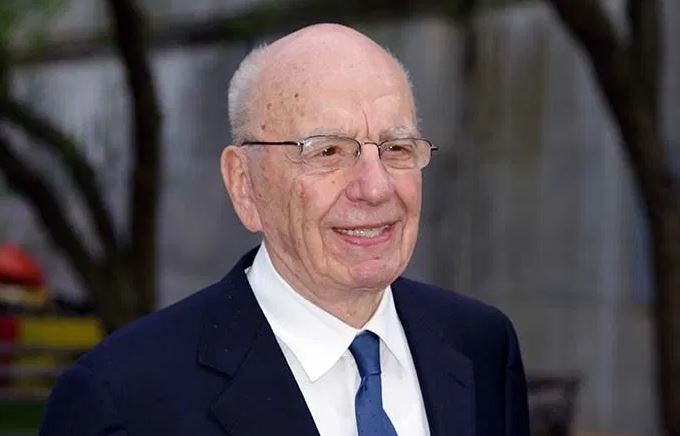
29. Rupert Murdoch, Australia
Born: Melbourne, Australia
Nobody encapsulates what it means to be a global media mogul quite like Rupert Murdoch, former acting CEO of Fox News and current chairman of the Fox Corporation. Born Keith Rupert Murdoch in Melbourne, Australia in 1931, Murdoch is the son of Sir Keith Murdoch and Dame Elisabeth Murdoch, who themselves had English, Scottish, and Irish ancestors. And while he may be the man behind a large portion of American news media, Murdoch’s paper trail actually stretches around the world.
Some might say that Murdoch had the news in his blood. Sir Keith was an avid newspaperman who owned two regional papers in Adelaide, South Australia and was chairman of the Herald and Weekly Times group. It must have been inspiring to a young Murdoch, who started his own journalism career in grammar school, serving as the co-editor of one student-run journal and the editor of another. From there he went on to a part-time job at the Melbourne Herald, a job provided by Sir Keith who was trying to encourage Murdoch to join the family business—which Murdoch did upon Sir Keith’s death from cancer when Murdoch was 21.
Murdoch got to work right away growing his father’s media holdings into what would eventually become the Murdoch empire that we know today; an endeavor that stretches beyond newspapers into television broadcasting, music production, and more. Throughout the 1950s and 1960s, Murdoch expanded these holdings across Australia and New Zealand. He expanded even further, into the United Kingdom, in the late 1960s, and in 1974 moved to New York City to focus on the U.S. market.
Since immigrating to the United States, Murdoch has been nearly unstoppable in his business growth. He purchased The New York Post in 1976, 20th Century Fox in 1984, and Dow Jones & Company in 2007, all while maintaining extensive assets in his other global enterprises, including those in Europe and Asia. In 1985, Murdoch gave up his Australian citizenship and became a naturalized U.S. citizen, a move that was legally necessary in order for him to own and operate U.S. television stations. Today, he is the 34th richest person in the US and the 96th richest person in the world.
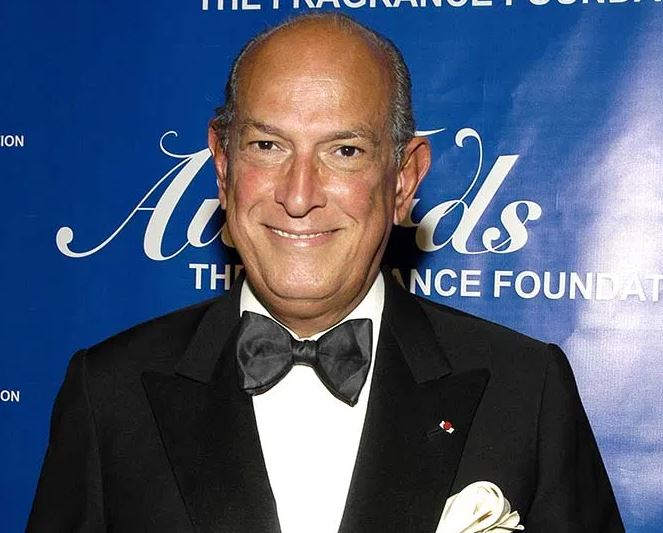
30. Oscar de la Renta, Dominican Republic
Born: Santo Domingo, Dominican Republic
Oscar de la Renta was born the youngest of seven children to a Dominican mother and Puerto Rican father in 1932. On his mother’s side, his ancestry can be traced far back into Dominican history, with evidence of the family in the country going all the way back to the 1600s. As long-standing statesmen, many of his maternal family members held important jobs in the Dominican Republic in the military and academic fields. Meanwhile, his paternal great-great-grandfather had been the longest serving mayor of Ponce, a city in Puerto Rico. Clearly, drive and success were already in his blood.
At 18, de la Renta moved to Spain to study painting at the Academy of San Fernando in Madrid. To make some money, he began drawing garments for newspapers and fashion companies, a common job prior to widespread printing capabilities. His fashion career took off with gusto after Francesca Lodge, wife of John Davis Lodge, then the U.S. Ambassador to Spain, saw his drawings and commissioned him to design a dress for her. In 1961, de la Renta moved to Paris to work for couture clothing company Lanvin.
De la Renta’s worldwide recognition as an exceptional fashion designer eventually led to another relocation, this time to the United States. He became a dual citizen of the U.S. and the Dominican Republic, and was considered by many to be an official ambassador for the latter country. His designs became a favorite among presidential first ladies and Hollywood starlets alike, but it his philanthropy that is perhaps de la Renta’s most powerful legacy. In the early 1980s, de la Renta adopted a son from a Dominican Republic orphanage, and spent many years of his life committed to raising funds for medical causes and the arts. He also financially supported the building of a school near his home in Punta Cana. He passed away in his home in Kent, Connecticut in 2014.











